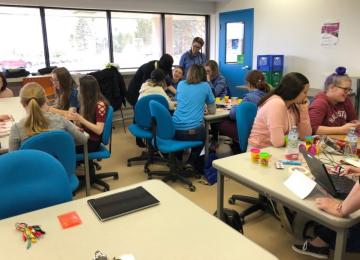
Justin Haley of Professional Engineers & Geoscientists Newfoundland & Labrador shares the work his organization is doing to achieve 30 by 30.

The 30 by 30 Champions Group, which consists of more than 40 members nationwide, works on strategy and action plans to improve the recruitment, retention, and professional development of women in engineering. They are a major force for change in the engineering profession, and an essential part of Engineers Canada’s goal to see the percentage of newly licensed engineers who are women climb to 30 percent by the year 2030.
This month we spoke with Justin Haley, 30 by 30 Champion for the Professional Engineers & Geoscientists Newfoundland & Labrador, on the work his organization is doing to achieve 30 by 30.
What are some highlights from your 30 by 30 work that you’d like to share with us?
PEGNL has partnered with local organizations to encourage and train our license holders to mentor young girls through STEM-based programs. We are a sponsor of the Women in Resource Development Corporation’s Techsploration program, which provides opportunities to explore technical and technology-related fields.
We have also developed a diversity and inclusion survey, which will help us gain a better understanding of the barriers and retention issues women face in engineering in our province. Along with this, we have developed volunteer guidelines that aim to increase the presence and visibility of female engineers within the organization and that have contributed to women comprising 70 per cent of our Board of Directors. Finally, we are developing a plan specific to businesses that will focus on promoting the benefits of, and eliminating the issues preventing, greater inclusion of women in engineering positions.
What do you see as the key barriers to achieving 30 by 30?
Short term, it’s ensuring that the percentage women enrolling in Canadian engineering programs is high enough. While our end goal is for the percentage of newly licensed women engineers in 2030, the people who will get licensed in that year will be entering post-secondary education in the next two-to-three years. Many of these students have already chosen career paths, and if we don’t ensure at least 30 per cent of Canadian engineering students are women during this key threshold, we dramatically reduce our chances of achieving the 30 by 30 goal.
What are the most important things you've learned as a 30 by 30 Champion that others would benefit from knowing?
The value of educating others on how everyone benefits from a diverse engineering profession. The public can often have a narrow view on what engineers do and not realize the many important decisions engineers make that would benefit from having varying viewpoints and experiences. Using real-world examples of how diversity and inclusion have helped advance engineering and the output of those practicing in the field can help illustrate the importance of greater involvement by women.
What do you think it will take to achieve 30 by 30 nationwide?
Partnerships. There are so many things that are being done by other organizations with similar mandates and goals, who have different skills, strengths, and resources than we do. Educational institutions, employers, varying levels of government, non-profits, and we as regulators all have specific assets and expertise that—when combined—can help foster meaningful change. Finding those with a common goal and developing programming or even supporting wherever possible can be incredibly meaningful to solving the problem. Additionally, partnerships make it easier to take an idea that’s worked in one jurisdiction and apply it to another.


